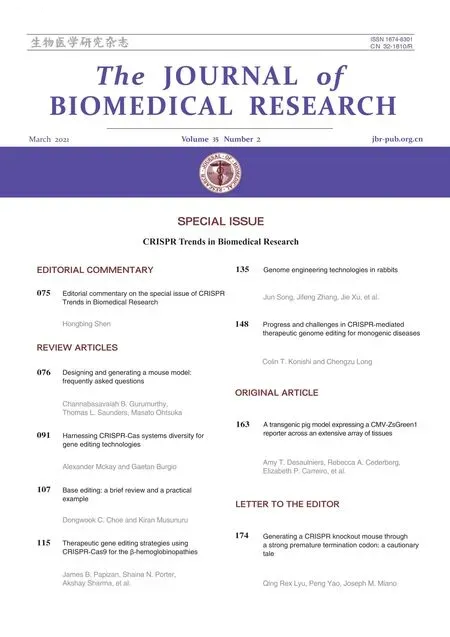Editorial commentary on the special issue of CRISPR Trends in Biomedical Research
Hongbing Shen
Editor-in-Chief, Journal of Biomedical Research.
In 2012, the laboratories of Drs. Emmanuelle Charpentier and Jennifer Doudna reported the repurposing of a bacterial adaptive immune system,known as CRISPR, as a programmable, RNA guided DNA editing system in eukaryotic cells. Over the next 12 months, a tsunami of research papers emerged demonstrating the facile utilization of this newfound genome editing platform in a variety of cell types and animal models. Since 2013, we have witnessed"global CRISPRization" with applications ranging from preservation of key crops and gene drives for the potential control of insect-borne diseases such as malaria and dengue to somatic genome editing with scores of clinical trials underway. From an experimental perspective, CRISPR has revolutionized and democratized the development of novel animal models across species and provided key insights into new gene therapies for a variety of hereditary diseases. Not surprisingly, though arguably somewhat late in coming, the 2020 Nobel Prize in Chemistry was awarded to Drs. Charpentier and Doudna "for the development of a method for genome editing".
Fittingly, this issue of theJournal of Biomedical Researchfocuses on developments in CRISPR editing technologies and their applications in experimental and clinical settings. Though the field is changing at a ferocious pace, these articles represent a focused snapshot of where we are in the CRISPR revolution in 2021.
We hope the readership will be inspired to embrace this astonishingly powerful new tool to further advance their research projects.
Finally, we thank the guest editor Dr. Joseph Miano at the Augusta University, USA, for his outstanding organizational efforts that make this special issue possible.
 THE JOURNAL OF BIOMEDICAL RESEARCH2021年2期
THE JOURNAL OF BIOMEDICAL RESEARCH2021年2期
- THE JOURNAL OF BIOMEDICAL RESEARCH的其它文章
- Generating a CRISPR knockout mouse through a strong premature termination codon: a cautionary tale
- A transgenic pig model expressing a CMV-ZsGreen1 reporter across an extensive array of tissues
- Progress and challenges in CRISPR-mediated therapeutic genome editing for monogenic diseases
- Genome engineering technologies in rabbits
- Therapeutic gene editing strategies using CRISPR-Cas9 for the β-hemoglobinopathies
- Base editing: a brief review and a practical example
